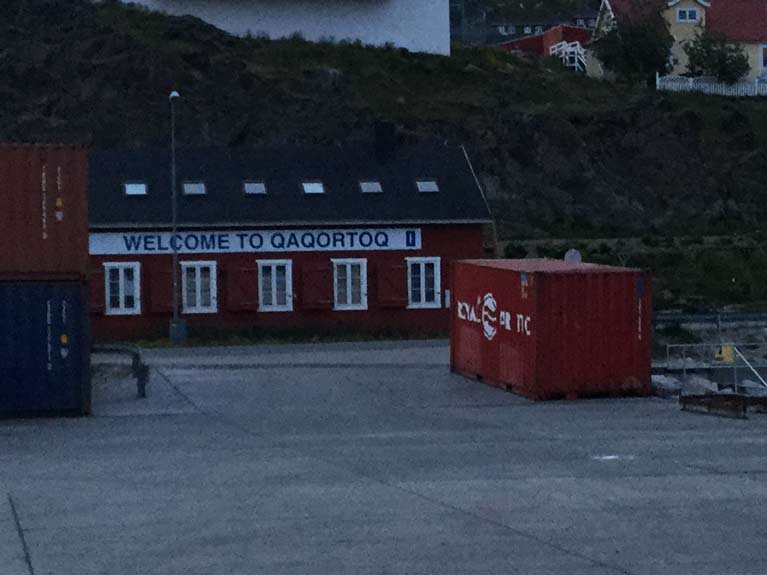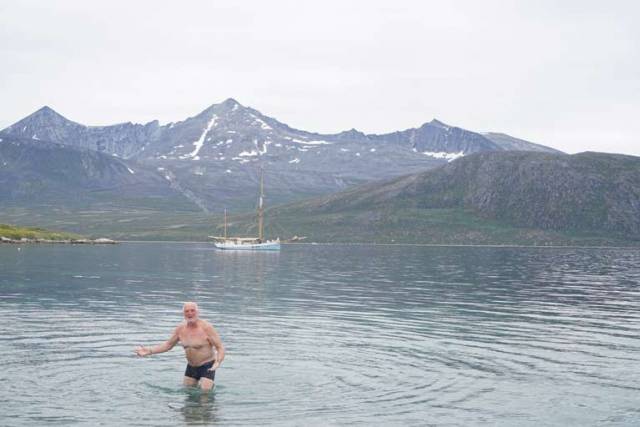After an arduous voyage of constant fog and one serious storm en route to Greenland, Ireland’s oldest sailing trading ketch Ilen has encountered its first clear evidence of climate change.
“When our skipper, Paddy Barry, was approaching Cape Farewell on Greenland’s southern tip back in 2001, he was met with ice,” crew member and Kerry musician Breanndán Ó Beaglaoich told Afloat by satellite phone.
“We had no such problems, nor have we seen any snow on any hills – Greenland is purely green,” he said. “If anyone doubted climate change’s impacts, they only have to come north.”
 Seamus O’Byrne (Ilen Skipper Paddy Barry’s secret twin) in Greenland. Ice and snow much is less than it was on Barry's previous visit in 2001 Photo: Breanndán Ó Beaglaoich
Seamus O’Byrne (Ilen Skipper Paddy Barry’s secret twin) in Greenland. Ice and snow much is less than it was on Barry's previous visit in 2001 Photo: Breanndán Ó Beaglaoich
The 1200 nautical mile voyage by the Ilen from the Shannon estuary up the west Greenland coast is intended to follow the migratory route of the wild Atlantic salmon. The restored ketch, originally built over 90 years ago by global circumnavigator Conor O’Brien, from Limerick, had proved its worth since it left the Shannon estuary in late June, Ó Beaglaoich says.
Limerick graphic artist Gary McMahon, who spearheads the community project to rebuild the vessel, is on board, along with Barry, Ó Beaglaoich, Mike Grimes, Mantas Seskanskis, James Madigan, Ronan O Caoimh, Mick Ruane, Seamus O’Byrne and Justin McDonagh.
“We had eight to nine days of fog, and we saw neither sun, moon, stars or any other boat, “Ó Beaglaoich recalls. “One of our crew joked we could have been going around in circles, were it not for our navigation.”
“We were about 300 nautical miles off the Greenland coast when we hit a storm, and I think it was probably the worst seas I have ever experienced,” Ó Beaglaoich, who rowed from Ireland to Spain in a Kerry naomhóg, says.
“At one point, Paddy Barry, who is 76 years of age, sat up in his bunk in the middle of the storm, and exclaimed that it was great to be alive,” Ó Beaglaoich says. “My answer was that it was great to be alive, but I’d prefer to be alive somewhere else! “

“When we arrived into Cape Farewell, the Inuit people who welcomed us were so kind and compassionate, and I have discovered that music and being at sea are my two favourite things in life,” he said.

“The Ilen hasn’t done a voyage like this since it was built by O’Brien in west Cork back in the 1920s and taken to the Falkland Islands, so the ketch really proved its worth,” he said.
The crew will deliver a traditional Limerick Shannon salmon-fishing cot which the Ilen boatbuilding school constructed, as a gift from Limerick city to the people of Nuuk, Greenland’s capital city.
The ultimate destination is Disko Bay, western Greenland’s largest open bay, which has been gradually warming since 1997.
Last month, Irish adventurer Jamie Young set sail for Greenland onboard his 15m aluminium yacht Killary Flyer, as part of a two-year Dutch-Irish film project to document the impact of climate change.



























































